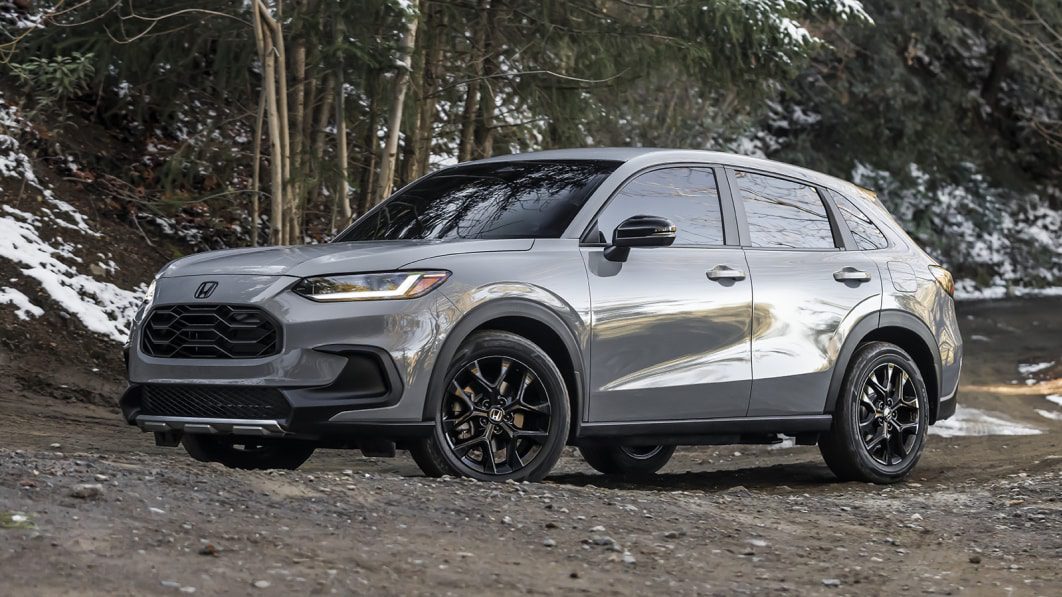2023 Honda HR-V pricing and specs revealed

Following a cursory reveal, the 2023 Honda HR-V’s pricing and specs have been announced. It’s bigger and more powerful than its predecessor. As a result, it’s also more expensive and not quite as fuel efficient as before.
Styling of the HR-V is a significant change, and it’s a shift to more conventional SUV design. The nose is meaner and more aggressive, in keeping with the similarly updated Ridgeline and Passport. The door handles are fully conventional, abandoning the semi-concealed rear handles of the old model, and the rear end is fairly plain.
Of course the whole car is bigger, too, at 9.4 inches longer and 2.6 inches wider. This translates into a passenger area that should feel more spacious. But cargo space is nearly identical to the smaller outgoing model with 24.4 cubic feet of space behind the rear seats, and 55.1 cubic feet with the seats folded. The reason is the new HR-V does not get the old HR-V’s “Magic Seat” in the back. By moving the gas tank under the front seats, the load floor and flat-folding back seat were extremely low, therefore providing far more cargo space than its exterior dimensions would suggest. The “Magic Seat” bottom also flipped up to free up floor space. We’ll miss the versatility, but at least its volume is maintained.
On the topic of the interior, the design here is closely related to the new Honda Civic. That’s not entirely a surprise, as it and the HR-V share a platform (the old HR-V shared its platform with the Fit). The low dash features full-width air vents, physical climate control dials and a central touchscreen infotainment. The standard infotainment is a 7-inch unit, with a 9-inch unit available. There is a little nod to the old HR-V with the open pass-through in the center console.
With its close relation to the new Civic, the new HR-V does see a number of mechanical improvements. It now has a multi-link rear suspension, and it gets a bigger, more powerful engine. It’s a naturally aspirated 2.0-liter four-cylinder making 158 horsepower and 138 pound-feet of torque (improvements of 17 horses and 11 pound-feet over the old model). A CVT is the only transmission option, but the HR-V can be had with front- or all-wheel drive. With the extra power and size comes a small fuel economy penalty. It gets 26 mpg in the city, 32 on the highway and 28 combined with front-wheel drive. With all-wheel drive, it gets 25 mpg in the city, 30 on the highway and 27 combined. The previous HR-V would get between 28 and 30 mpg combined.
Versions of the American HR-V in overseas markets will be available with a hybrid, but Honda hasn’t confirmed a hybrid for the United States. But with the Civic getting a hybrid, too, it’s hard to imagine Honda wouldn’t offer it, here.
Pricing has risen for the new HR-V. The base model starts at $24,895, an increase of nearly $1,800. All-wheel drive adds another $1,500. Pricing for all three trims is listed below.
LX: $24,895
Sport: $26,895
EX-L: $28,695
Standard features for the HR-V include 17-inch alloy wheels, the 7-inch infotainment screen and Apple CarPlay and Android Auto. Safety features include adaptive cruise control, lane-keep assist, automatic emergency braking, driver alertness monitor and rear-seat reminder. Opting for the Sport trim adds 18-inch wheels, a polished exhaust tip, unique grille, black badging and a black rear spoiler. It also has unique cloth and contrasting bronze-colored stitching, plus blind-spot monitoring. The top EX-L has a leatherette interior, the 9-inch infotainment and wireless Apple CarPlay and Android Auto. If the HR-V sounds interesting to you, you’ll be able to find it on dealer lots in June.



